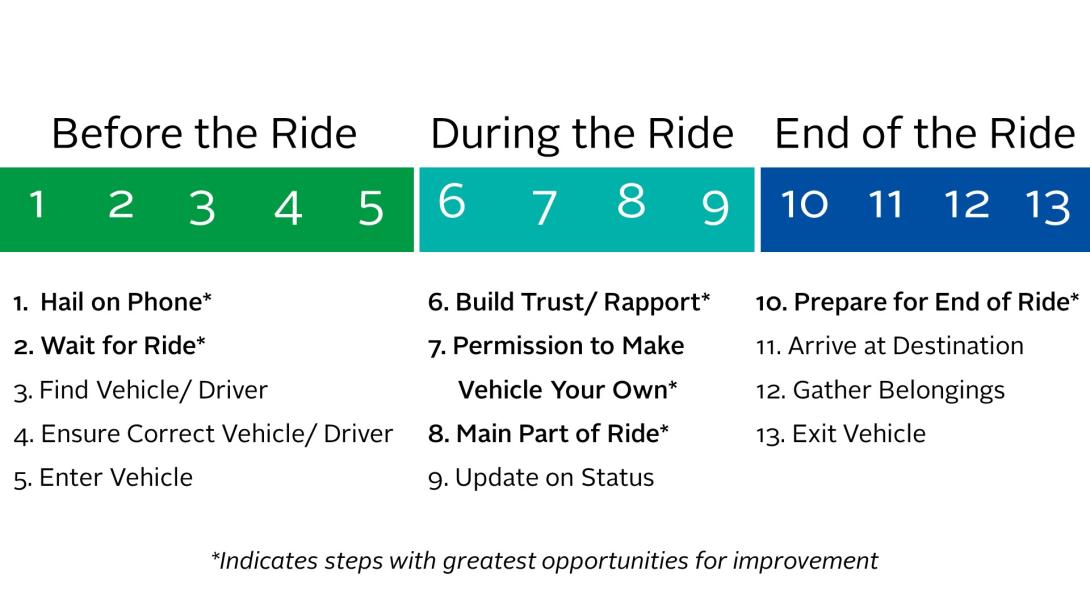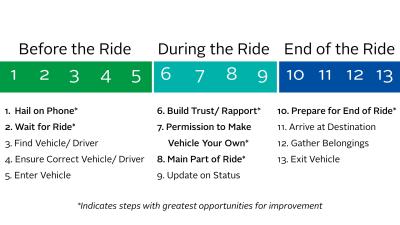Yanfeng, a leading global automotive supplier, recently released proprietary research conducted by its global User Research team, which examines passenger experiences during the ride-hailing journey. The study, conducted prior to the COVID-19 pandemic, included participants from China and the U.S., offering insights into the factors that influence the passenger experience. The findings concluded that the ride-hailing experience is nuanced, consisting of 13 steps within three main phases: before, during and after the ride.

Summary of the Ride-Hailing Journey
"People's perception of ride-sharing is not as simple as a five-star review," said Senior Analyst, Global User Research Cathy Bailey, the study's lead. "The ride-sharing experience isn't just one simple equation – it's the sum of its parts. If any of these phases fall short, a passenger's positive perception of the experience will dwindle. That becomes a threat to any service provider looking to create a brand loyal customer base, especially as we anticipate the landscape to become more and more service-oriented."
The Yanfeng team found that the six steps with the greatest opportunities for improvement within the entire 13-step journey include hailing the ride on the phone, waiting for the ride, building trust and rapport, permission to make vehicle your own, the main part of the ride and preparing for the end of the ride. These six steps are transition times that are critical to ridehailers and are currently pain points with room for improvement.
The top ride-hailing use case scenarios reported in the research included going out, commuting to work, and running errands. During these scenarios, passengers used their time to relax, accomplish tasks, or engage throughout the ride. Passenger's use cases and preferences varied by region.
In China, ride-sharing was used more frequently overall and provided a time for passengers to relax. The study also noted that trip durations in China are longer, often exceeding 20 minutes. Comparatively, U.S. passengers on average took shorter and less frequent trips, using their ride time to engage with others. Both countries – 76% of China users and 73% of U.S. users – reported "going out" as the top reason for using rideshare services, closely followed by "commute to work" at 73% for China users and "running errands" at 58% for U.S. users.
Ultimately, the findings allow for an increased understanding of passenger expectations and needs during the ride-hail experience. "Before starting the study, we spent a significant amount of time familiarizing ourselves with what ride-sharing research was currently available. From our findings, we still were not getting a clear sense of what end-users perceived of the entire ride-sharing experience," says Beth McGough, Senior Manager, Global User Research. "That led us to conduct our own study. Understanding the stages the user goes through during the ride-hailing journey, how a user evaluates each stage, and how they prefer to spend their time is key to redesigning not only the ride-hailing experience, but reassessing how vehicles are optimized for the general passenger experience."
For automotive manufacturers, suppliers, and ride-hailing service providers, these insights serve as a guide to assess the functional integrations and features of the vehicle – an opportunity to offer users greater value and build brand affinity depending on how their needs are met.
"The current interior experience is focused on the driver, but the passenger's comfort and wellbeing are equally important. With the popularity of ride-sharing, we now have a large pool of users to survey," says Tim Shih, Yanfeng's VP of Design and User Experience. "As paying passengers, rideshare customers tend to be objective when evaluating their in-car experience (vs. their personally owned vehicles) and frequently compare these factors across different vehicle types."
By understanding the user's perspective, better onboard experiences can be cultivated for all passengers. With autonomous driving in the near future, the passenger experience will be the only onboard experience. Yanfeng's Smart Cabin vision is actively exploring solutions for today's and tomorrow's passenger needs.
User and Market Research
The findings of this ride-hailing research are complemented by Yanfeng's Quality of Life (QoL) study. In this study, Yanfeng explored the dimensions that impact people's perception of memorable experiences. The significance of the QoL and the Ride-Hailing study is the algorithmic nature of their insights. When analyzed side-by-side, automotive manufacturers, suppliers, and ride-hailing service providers can emphasize experiential functions and features at the key points of the passenger's journey to influence user's perception of their time in-vehicle.
Read more about the 'Quality of Life' research study.
Yanfeng has advanced its user research methods to involve current and potential future groups along with market trend research, target group research, brand perception research, interior product analysis, and new concept test research. The company integrates critical findings into the product development process by partnering with design teams to build intuitive solutions that are simple for users to understand and operate.
XiM21s
The results of this research contributed to the design and development of the company's Smart Cabin concept car Experience in Motion 2021s (XiM21s). The passenger-focused interior concept, XiM21s, was recently honored with a Red Dot Design Concept Award in the category "Mobility and Transportation" for demonstrating how integrated technology can create an intuitive and customized environment tailored to the end users' needs and expectations. Experience the XiM21s interior on Yanfeng's YouTube channel.
About Yanfeng:
Yanfeng is a leading global automotive supplier, focusing on interior, exterior, seating, cockpit electronics, and passive safety, and is exploring new business actively. Yanfeng has more than 240 locations and approximately 57,000 employees worldwide. The technical team of 4,100 experts is in 14 R&D centers and other regional offices, with complete capabilities including engineering and software development, styling, and test validation. Focusing on Smart Cabin and lightweight technology, Yanfeng supports automakers to explore future mobility and provide leading cabin solutions.
Public Relations - North America
Media Contact
Press Images



 LinkedIn
LinkedIn
 Instagram
Instagram
 YouTube
YouTube